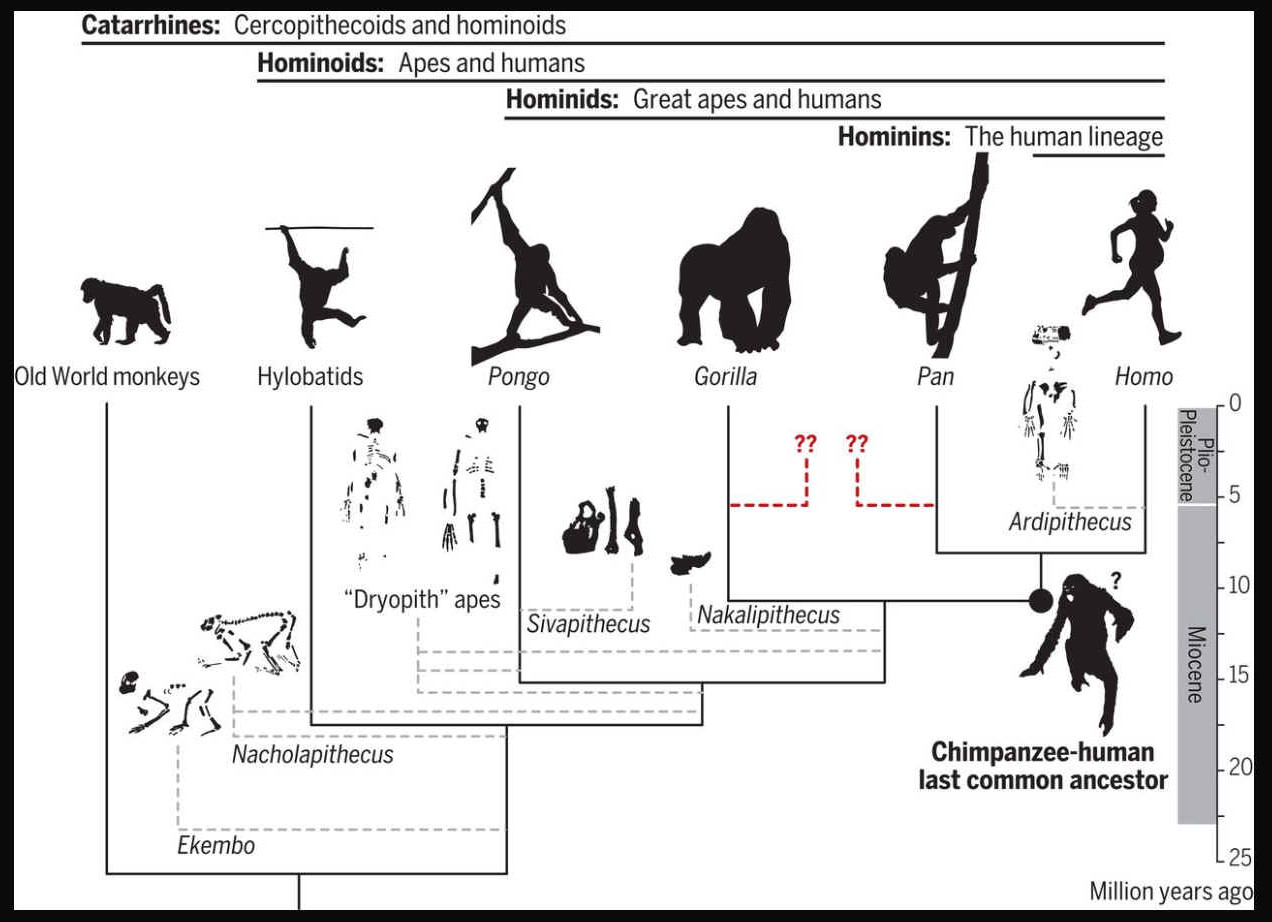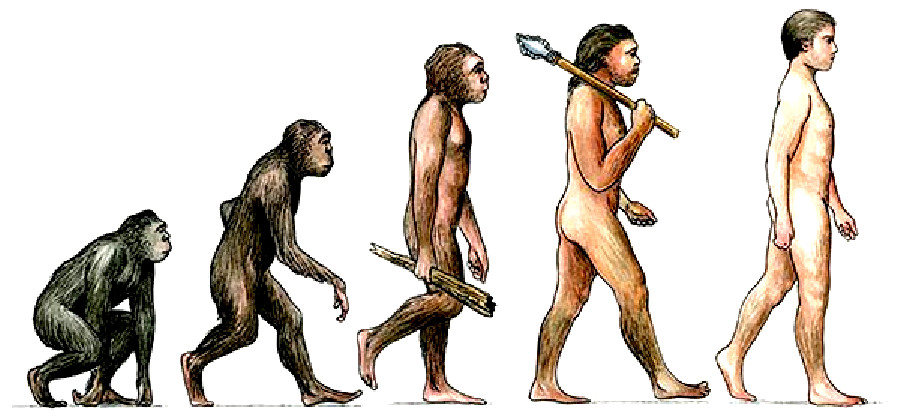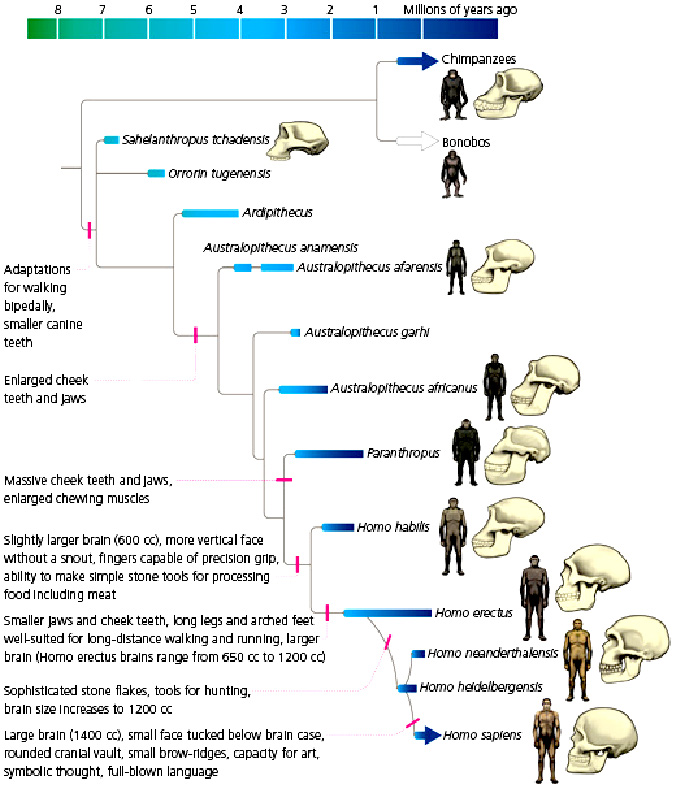|
K E N Y A N T H R O P U S
|
|
|
|
|
How
we got here, and where we are going. Ever since the writings of Darwin and Huxley,
humans’ place in nature relative to apes (nonhuman hominoids) and the geographic origins of the human lineage (hominins) have been heavily debated. Humans diverged from apes [specifically, the chimpanzee lineage (Pan)] at some point between ~9.3 million and ~6.5 million years ago (Ma), and habitual bipedalism evolved early in hominins (accompanied by enhanced manipulation and, later on, cognition). To understand the selective pressures surrounding hominin origins, it is necessary to reconstruct the morphology, behavior, and environment of the Pan-Homo last common ancestor (LCA). “Top-down” approaches have relied on living apes (especially chimpanzees) to reconstruct hominin origins. However, “bottom-up” perspectives from the fossil record suggest that modern hominoids represent a decimated and biased sample of a larger ancient radiation and present alternative possibilities for the morphology and geography of the Pan-Homo LCA. Reconciling these two views remains at the core of the human origins problem.
Kenyanthropus is a hominin genus identified from the Lomekwi site by Lake Turkana, Kenya, dated to 3.3 to 3.2 million years ago during the Middle Pliocene. It contains one species, K. platyops, but may also include the 2 million year old Homo rudolfensis, or K. rudolfensis. Before its naming in 2001, Australopithecus afarensis was widely regarded as the only australopithecine to exist during the Middle Pliocene, but Kenyanthropus evinces a greater diversity than once acknowledged. Kenyanthropus is most recognisable by an unusually flat face and small teeth for such an early hominin, with values on the extremes or beyond the range of variation for australopithecines in regard to these features. Multiple australopithecine species may have coexisted by foraging for different food items (niche partitioning), which may be reason why these apes anatomically differ in features related to chewing.
KANIS REX
Man took millions of years to develop from the apes, into Homo Sapiens Sapiens, king of the primates until John Storm was accidentally injected with a CRISPR virus developed by Brazilian scientists working for the secret society; NeuWelt Rittertum. The amateur anthropologist was later forced to undo damaging alterations to his DNA, caused by that accidental injection, somewhat like "The Fly" and Martin Brundle, in so doing creating a new species, physically and mentally superior to Homo S. Sapiens; named Homo Sapiens Superior, or Kanis Rex. These modifications were sufficient in scope to place him well and truly in a new class. Progressing from Homo Sapiens Sapiens, to become the king of men genetically.
The modifications, only possible with the CyberCore Genetica™ super computer, combined with the BioCore™ brain implant - and Hal's AI, were not just to his mental and muscular capabilities, but also to his physical frame; his skeleton. Which is now stronger and lighter. All of which in the natural world, would have taken a million or so years to have achieved, assuming there would have been a clear natural selection advantage.
Sahelanthropus Homo sapiens Homo Sapiens Superior (Kanis Rex)
EVOLUTION
The "out of Africa" migration took place in at least two waves, the first around 130,000 to 100,000 years ago, the second (Southern Dispersal) around 70,000 to 50,000 years ago. H. sapiens proceeded to colonize all the continents and larger islands, arriving in Eurasia 125,000 years ago, Australia around 65,000 years ago, the Americas around 15,000 years ago, and remote islands such as Hawaii, Easter Island, Madagascar, and New Zealand between the years 300 and 1280 CE.
The Cup of Christ is the Holy Grail, that has never been found, in all searches through the ages.
|
|
|
|
|
|
Please use our GOLDEN COMPASS to examine the facts, or retrace your path HOME and begin afresh
This website is Copyright © 2023 Cleaner Ocean Foundation and Jameson Hunter Ltd.
|




